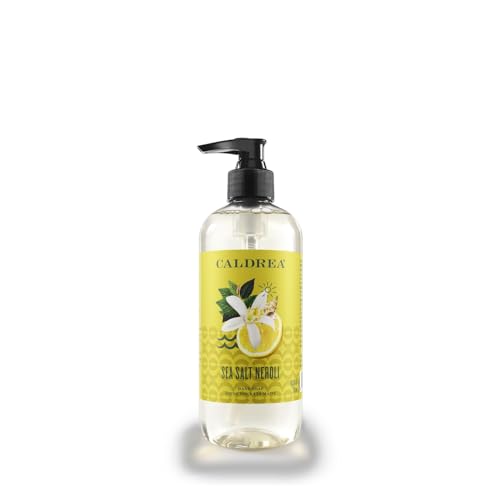

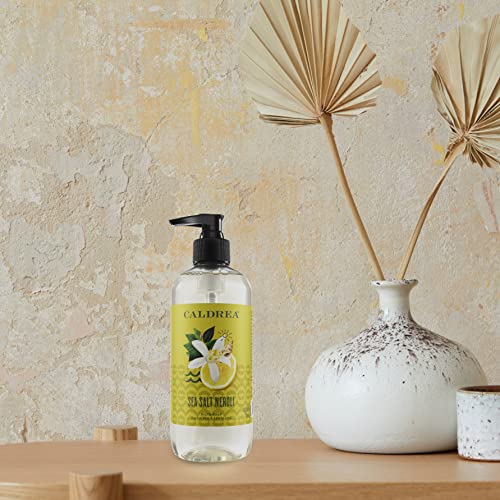
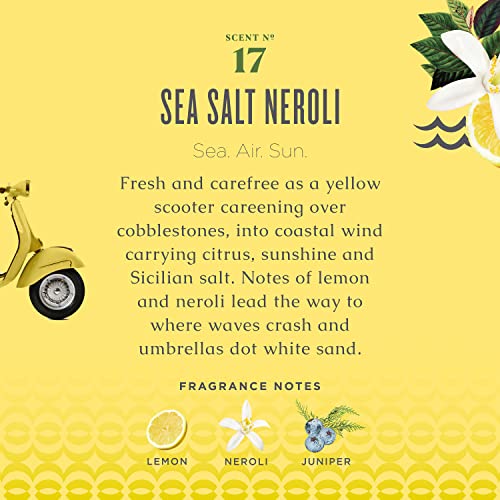
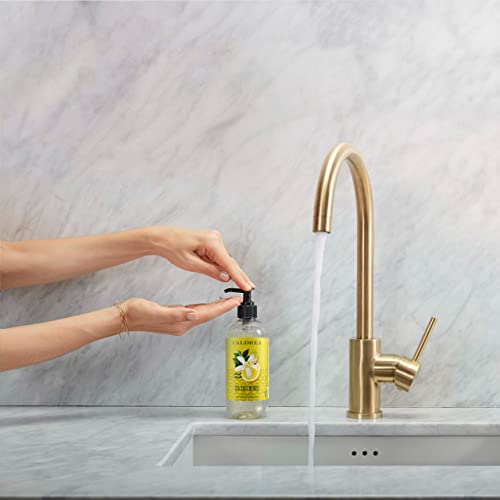
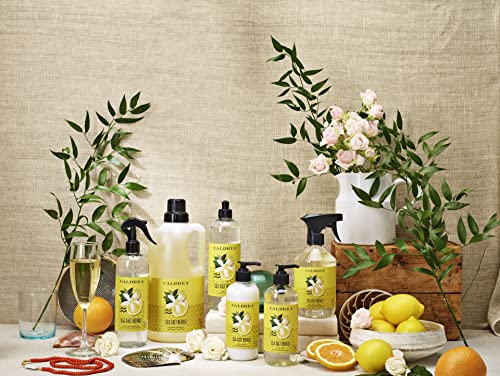
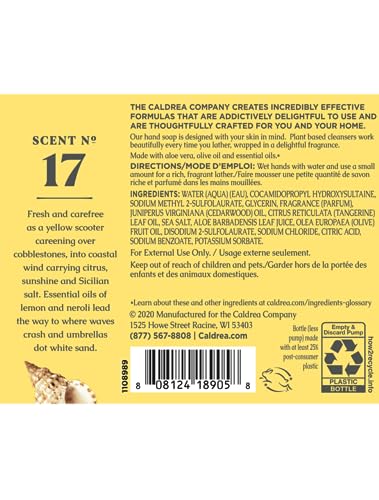
Caldrea Hand Soap - Gentle Cleanser with Aloe Vera & Olive Oil, Sea Salt Neroli Scent - 10.8oz


Citrus Aurantium Dulcis (Orange) Flower Oil
Medium RiskCitrus aurantium dulcis (orange) flower oil is an essential oil derived from the blossoms of the sweet orange tree. It is commonly used in cosmetic and personal care products for its fragrance and potential skin benefits.
Sustai Insights
Citrus aurantium dulcis (orange) flower oil offers functional benefits as a natural fragrance and skin-soothing agent, with moderate sustainability credentials. However, it poses a high allergenic potential and may cause skin irritation in sensitive individuals. Regulatory bodies have noted moderate use restrictions. Overall, the risk associated with this ingredient is assessed as medium, necessitating caution in its application.
Potassium Sorbate
Medium RiskPotassium sorbate is a potassium salt of sorbic acid, primarily used as a preservative in food and cosmetic products. It inhibits the growth of molds, yeast, and some bacteria, extending the shelf life of products. It is commonly found in various formulations due to its effectiveness and low toxicity.
Sustai Insights
Potassium sorbate serves as an effective preservative, preventing microbial growth in food and cosmetic products, which is vital for safety and longevity. Although it has a low risk of carcinogenicity and developmental toxicity, there is a moderate concern regarding allergies and immunotoxicity. Environmentally, it poses minimal risks as it is not significantly bioaccumulative. Regulatory agencies have verified its use, although some products may face restrictions. Overall, it is assessed as a medium risk ingredient, with safe usage practices recommended, and alternatives such as natural preservatives could be considered.
Citric Acid
Medium RiskCitric acid is an alpha hydroxy acid used in personal care products primarily for its role as a pH adjuster and natural preservative. It occurs naturally in citrus fruits and is commonly utilized in various formulations for its chelating properties and mild exfoliation benefits.
Sustai Insights
Citric acid offers functional benefits as an effective preservative and pH stabilizer, contributing to product longevity and stability. It is biodegradable and derived from renewable sources. Health risks are low, with minimal concerns regarding carcinogenicity, allergies, and reproductive toxicity. However, moderate use restrictions exist due to potential irritation at high concentrations. Environmental risks are limited, as citric acid is not known to accumulate in ecosystems. Regulatory agencies have no significant advisories against its use. Overall, it is assessed as a medium-risk ingredient, with safe usage practices recommended and alternatives available.
Sodium Benzoate
Medium RiskSodium benzoate is a preservative commonly used in food and cosmetic products to prevent microbial growth and extend shelf life. It is derived from benzoic acid and is effective at low concentrations, often used in acidic environments like beverages and condiments.
Sustai Insights
Sodium benzoate serves effectively as a preservative, contributing to product stability and safety. It is generally recognized as safe with low concerns for carcinogenicity, allergies, and reproductive toxicity, though it faces moderate use restrictions in some regions. Environmental risks include its potential as a pollutant, but it does not bioaccumulate significantly. Regulatory bodies have issued advisories regarding its concentration in products. Overall, the risk level is assessed as medium, with safe usage practices recommended. Alternatives such as potassium sorbate may provide similar benefits with potentially lower restrictions.
Disodium 2 Sulfolaurate
Low RiskDisodium 2 sulfolaurate is a surfactant and emulsifying agent commonly used in personal care products. It functions primarily to help cleanse, foaming, and stabilize formulations, enhancing the overall texture and performance of the product.
Sustai Insights
Disodium 2 sulfolaurate offers functional benefits as an effective surfactant, improving product stability and user experience. It is considered to have low health risks, with no significant concerns regarding carcinogenicity, allergenic potential, or reproductive toxicity. Environmental risks are minimal, with no evidence of bioaccumulation or significant pollution. Regulatory assessments indicate no current restrictions, affirming its safe use. Overall, the risk level is low, making it a suitable ingredient in formulated products.
Citrus Limon (Lemon) Peel
Low RiskCitrus limon (lemon) peel is derived from the outer skin of lemons and is commonly used in cosmetic formulations for its aromatic properties and potential skin benefits. It serves primarily as a fragrance agent and may also provide antioxidant effects.
Sustai Insights
Citrus limon (lemon) peel is valued for its aromatic contributions and potential antioxidant properties, which can enhance product appeal. It has a low risk of adverse health effects, including low concerns for carcinogenicity, allergies, and irritation. Environmental risks are minimal, with no significant evidence of bioaccumulation or pollution. Regulatory assessments indicate no restrictions on use. Overall, it is considered low risk, and safe usage practices should be maintained. Alternatives may include other citrus peels or natural fragrance compounds.
Olea Europaea (Olive) Oil
Low RiskOlea europaea (olive) oil is derived from the ripe fruit of the olive tree. It is commonly used in cosmetic formulations primarily as a moisturizer and emollient due to its nourishing properties for the skin. It also serves as a carrier oil for other ingredients in formulations.
Sustai Insights
Olea europaea (olive) oil offers numerous functional benefits, including effective moisturization and enhanced skin absorption properties, making it suitable for various cosmetic applications. It is a biodegradable ingredient, contributing to sustainability when sourced responsibly. Health risks are low, with minimal concerns regarding carcinogenicity, allergenic potential, and developmental toxicity. Environmental risks are also low, with no significant bioaccumulation or pollution potential noted. Regulatory bodies do not impose restrictions on its use. Overall, olive oil presents a low risk profile, making it a favorable choice in cosmetic products.
Sodium Methyl 2 Sulfolaurate
Low RiskSodium methyl 2 sulfolaurate is a surfactant primarily used in personal care and cleaning products. It functions to reduce surface tension, enabling better spreading and cleaning properties. This ingredient is typically derived from renewable resources and is noted for its mild nature in formulations.
Sustai Insights
Sodium methyl 2 sulfolaurate offers functional benefits as an effective surfactant, contributing to the cleaning efficacy of products while being derived from renewable sources, which supports sustainability. Health risks are considered low, with no significant concerns regarding carcinogenicity, allergies, or reproductive toxicity. Environmental risks are also low, as it does not bioaccumulate or contribute significantly to pollution. Regulatory bodies do not impose restrictions on its use. Overall, this ingredient presents a low-risk profile, with no notable adverse effects, making it a viable option in formulations.
Cocamidopropyl Hydroxysultaine
Low RiskCocamidopropyl hydroxysultaine is a synthetic skin and hair conditioning agent commonly used in personal care products. It functions primarily as a surfactant, providing foaming and emulsifying properties, while also contributing to the conditioning of hair and skin.
Sustai Insights
Cocamidopropyl hydroxysultaine offers functional benefits as a mild surfactant and conditioning agent, with low concerns regarding carcinogenicity, allergies, and reproductive toxicity. It is generally regarded as safe with low irritation potential. Environmental assessments indicate low pollutant potential and minimal bioaccumulation. Regulatory bodies have not imposed significant restrictions on its use, aligning with low risk levels overall. Safe usage is advised, particularly for sensitive populations, and alternative gentle surfactants may be considered for those seeking greener options. In conclusion, this ingredient is classified as low risk.
Vegetarian Glycerin
Low RiskVegetarian glycerin, also known as glycerol, is a colorless, odorless, and viscous liquid derived from plant sources. It is primarily used as a humectant, solvent, and emollient in various personal care products, helping to retain moisture and improve texture.
Sustai Insights
Vegetarian glycerin offers functional benefits as an effective humectant, promoting hydration and skin smoothness. It is biodegradable and typically sustainably sourced. Health risks associated with glycerin are low, with no significant concerns for carcinogenicity, allergens, or reproductive toxicity. Environmental risks are minimal, and it is not subject to major regulatory warnings. Overall, the risk level for this ingredient is low, making it a safe choice in formulations. Safe usage practices include ensuring proper concentrations in products, and alternatives such as propylene glycol exist but may have differing properties.
Sea Salt
Low RiskSea salt is a mixture of inorganic salts derived primarily from the evaporation of seawater. It consists mainly of sodium chloride, with minor amounts of other minerals. Sea salt is commonly used as a seasoning and preservative in food products and may also have applications in cosmetics and personal care items.
Sustai Insights
Sea salt serves as an effective flavor enhancer and preservative, contributing to the taste and shelf-life of food products. It is generally considered safe with low risk for health concerns such as cancer, allergies, and reproductive toxicity. Environmental impact is minimal, as it does not contribute significantly to pollution or bioaccumulation. Regulatory bodies, including the FDA, currently do not impose restrictions on its use. Overall, the risk level associated with sea salt is low, making it a widely accepted ingredient with no significant adverse effects reported.
Disodium 2 Sulfolaurate
Low RiskDisodium 2 sulfolaurate is a surfactant and emulsifying agent commonly used in personal care products. It functions primarily to help cleanse, foaming, and stabilize formulations, enhancing the overall texture and performance of the product.
Sustai Insights
Disodium 2 sulfolaurate offers functional benefits as an effective surfactant, improving product stability and user experience. It is considered to have low health risks, with no significant concerns regarding carcinogenicity, allergenic potential, or reproductive toxicity. Environmental risks are minimal, with no evidence of bioaccumulation or significant pollution. Regulatory assessments indicate no current restrictions, affirming its safe use. Overall, the risk level is low, making it a suitable ingredient in formulated products.
Citrus Aurantium Dulcis (Orange) Flower Oil
Medium RiskCitrus aurantium dulcis (orange) flower oil is an essential oil derived from the blossoms of the sweet orange tree. It is commonly used in cosmetic and personal care products for its fragrance and potential skin benefits.
Sustai Insights
Citrus aurantium dulcis (orange) flower oil offers functional benefits as a natural fragrance and skin-soothing agent, with moderate sustainability credentials. However, it poses a high allergenic potential and may cause skin irritation in sensitive individuals. Regulatory bodies have noted moderate use restrictions. Overall, the risk associated with this ingredient is assessed as medium, necessitating caution in its application.
Citrus Limon (Lemon) Peel
Low RiskCitrus limon (lemon) peel is derived from the outer skin of lemons and is commonly used in cosmetic formulations for its aromatic properties and potential skin benefits. It serves primarily as a fragrance agent and may also provide antioxidant effects.
Sustai Insights
Citrus limon (lemon) peel is valued for its aromatic contributions and potential antioxidant properties, which can enhance product appeal. It has a low risk of adverse health effects, including low concerns for carcinogenicity, allergies, and irritation. Environmental risks are minimal, with no significant evidence of bioaccumulation or pollution. Regulatory assessments indicate no restrictions on use. Overall, it is considered low risk, and safe usage practices should be maintained. Alternatives may include other citrus peels or natural fragrance compounds.
Olea Europaea (Olive) Oil
Low RiskOlea europaea (olive) oil is derived from the ripe fruit of the olive tree. It is commonly used in cosmetic formulations primarily as a moisturizer and emollient due to its nourishing properties for the skin. It also serves as a carrier oil for other ingredients in formulations.
Sustai Insights
Olea europaea (olive) oil offers numerous functional benefits, including effective moisturization and enhanced skin absorption properties, making it suitable for various cosmetic applications. It is a biodegradable ingredient, contributing to sustainability when sourced responsibly. Health risks are low, with minimal concerns regarding carcinogenicity, allergenic potential, and developmental toxicity. Environmental risks are also low, with no significant bioaccumulation or pollution potential noted. Regulatory bodies do not impose restrictions on its use. Overall, olive oil presents a low risk profile, making it a favorable choice in cosmetic products.
Potassium Sorbate
Medium RiskPotassium sorbate is a potassium salt of sorbic acid, primarily used as a preservative in food and cosmetic products. It inhibits the growth of molds, yeast, and some bacteria, extending the shelf life of products. It is commonly found in various formulations due to its effectiveness and low toxicity.
Sustai Insights
Potassium sorbate serves as an effective preservative, preventing microbial growth in food and cosmetic products, which is vital for safety and longevity. Although it has a low risk of carcinogenicity and developmental toxicity, there is a moderate concern regarding allergies and immunotoxicity. Environmentally, it poses minimal risks as it is not significantly bioaccumulative. Regulatory agencies have verified its use, although some products may face restrictions. Overall, it is assessed as a medium risk ingredient, with safe usage practices recommended, and alternatives such as natural preservatives could be considered.
Sodium Methyl 2 Sulfolaurate
Low RiskSodium methyl 2 sulfolaurate is a surfactant primarily used in personal care and cleaning products. It functions to reduce surface tension, enabling better spreading and cleaning properties. This ingredient is typically derived from renewable resources and is noted for its mild nature in formulations.
Sustai Insights
Sodium methyl 2 sulfolaurate offers functional benefits as an effective surfactant, contributing to the cleaning efficacy of products while being derived from renewable sources, which supports sustainability. Health risks are considered low, with no significant concerns regarding carcinogenicity, allergies, or reproductive toxicity. Environmental risks are also low, as it does not bioaccumulate or contribute significantly to pollution. Regulatory bodies do not impose restrictions on its use. Overall, this ingredient presents a low-risk profile, with no notable adverse effects, making it a viable option in formulations.
Citric Acid
Medium RiskCitric acid is an alpha hydroxy acid used in personal care products primarily for its role as a pH adjuster and natural preservative. It occurs naturally in citrus fruits and is commonly utilized in various formulations for its chelating properties and mild exfoliation benefits.
Sustai Insights
Citric acid offers functional benefits as an effective preservative and pH stabilizer, contributing to product longevity and stability. It is biodegradable and derived from renewable sources. Health risks are low, with minimal concerns regarding carcinogenicity, allergies, and reproductive toxicity. However, moderate use restrictions exist due to potential irritation at high concentrations. Environmental risks are limited, as citric acid is not known to accumulate in ecosystems. Regulatory agencies have no significant advisories against its use. Overall, it is assessed as a medium-risk ingredient, with safe usage practices recommended and alternatives available.
Sodium Benzoate
Medium RiskSodium benzoate is a preservative commonly used in food and cosmetic products to prevent microbial growth and extend shelf life. It is derived from benzoic acid and is effective at low concentrations, often used in acidic environments like beverages and condiments.
Sustai Insights
Sodium benzoate serves effectively as a preservative, contributing to product stability and safety. It is generally recognized as safe with low concerns for carcinogenicity, allergies, and reproductive toxicity, though it faces moderate use restrictions in some regions. Environmental risks include its potential as a pollutant, but it does not bioaccumulate significantly. Regulatory bodies have issued advisories regarding its concentration in products. Overall, the risk level is assessed as medium, with safe usage practices recommended. Alternatives such as potassium sorbate may provide similar benefits with potentially lower restrictions.
Cocamidopropyl Hydroxysultaine
Low RiskCocamidopropyl hydroxysultaine is a synthetic skin and hair conditioning agent commonly used in personal care products. It functions primarily as a surfactant, providing foaming and emulsifying properties, while also contributing to the conditioning of hair and skin.
Sustai Insights
Cocamidopropyl hydroxysultaine offers functional benefits as a mild surfactant and conditioning agent, with low concerns regarding carcinogenicity, allergies, and reproductive toxicity. It is generally regarded as safe with low irritation potential. Environmental assessments indicate low pollutant potential and minimal bioaccumulation. Regulatory bodies have not imposed significant restrictions on its use, aligning with low risk levels overall. Safe usage is advised, particularly for sensitive populations, and alternative gentle surfactants may be considered for those seeking greener options. In conclusion, this ingredient is classified as low risk.
Vegetarian Glycerin
Low RiskVegetarian glycerin, also known as glycerol, is a colorless, odorless, and viscous liquid derived from plant sources. It is primarily used as a humectant, solvent, and emollient in various personal care products, helping to retain moisture and improve texture.
Sustai Insights
Vegetarian glycerin offers functional benefits as an effective humectant, promoting hydration and skin smoothness. It is biodegradable and typically sustainably sourced. Health risks associated with glycerin are low, with no significant concerns for carcinogenicity, allergens, or reproductive toxicity. Environmental risks are minimal, and it is not subject to major regulatory warnings. Overall, the risk level for this ingredient is low, making it a safe choice in formulations. Safe usage practices include ensuring proper concentrations in products, and alternatives such as propylene glycol exist but may have differing properties.
Sea Salt
Low RiskSea salt is a mixture of inorganic salts derived primarily from the evaporation of seawater. It consists mainly of sodium chloride, with minor amounts of other minerals. Sea salt is commonly used as a seasoning and preservative in food products and may also have applications in cosmetics and personal care items.
Sustai Insights
Sea salt serves as an effective flavor enhancer and preservative, contributing to the taste and shelf-life of food products. It is generally considered safe with low risk for health concerns such as cancer, allergies, and reproductive toxicity. Environmental impact is minimal, as it does not contribute significantly to pollution or bioaccumulation. Regulatory bodies, including the FDA, currently do not impose restrictions on its use. Overall, the risk level associated with sea salt is low, making it a widely accepted ingredient with no significant adverse effects reported.
Experience the refreshing simplicity of Caldrea Sea Salt Neroli Hand Wash Soap, crafted with Aloe Vera, Olive Oil, and a unique blend of essential oils. This gentle yet effective hand soap not only cleanses but also conditions your skin, leaving it soft and nourished. Enjoy the invigorating scent as you elevate your daily handwashing routine.
- Gentle Cleanser: Designed for all skin types, it effectively removes dirt while moisturizing, thanks to Aloe Vera and Olive Oil.
- Nourishing Ingredients: Enriched with vegetable-derived glycerin, this hand soap ensures your hands remain hydrated and soft.
- Versatile Use: Perfect for handwashing, it's also suitable for delicate clothing items, providing a multi-use solution.
- Sustainable Sourcing: Made with essential oils and naturally derived ingredients, promoting a cleaner environment without compromising quality.
- Invigorating Aroma: The Sea Salt Neroli scent transforms handwashing into a delightful experience, uplifting your senses with every use.
Subscribe & Save with Sustai
- Best Price Guarantee: Always enjoy the lowest prices on sustainable home essentials.
- No Surprises: We’ll notify you before shipping. No hidden fees, ever.
- You’re in Charge: Change, pause, or cancel your subscription anytime with ease.
- Eco-Friendly Deliveries: Our grouped shipments mean less packaging and lower emissions.
Join us on a sustainable journey. Special offers for a limited time! Prices and promotions may change.
Recommended Products
Experience the refreshing simplicity of Caldrea Sea Salt Neroli Hand Wash Soap, crafted with Aloe Vera, Olive Oil, and a unique blend of essential oils. This gentle yet effective hand soap not only cleanses but also conditions your skin, leaving it soft and nourished. Enjoy the invigorating scent as you elevate your daily handwashing routine.
- Gentle Cleanser: Designed for all skin types, it effectively removes dirt while moisturizing, thanks to Aloe Vera and Olive Oil.
- Nourishing Ingredients: Enriched with vegetable-derived glycerin, this hand soap ensures your hands remain hydrated and soft.
- Versatile Use: Perfect for handwashing, it's also suitable for delicate clothing items, providing a multi-use solution.
- Sustainable Sourcing: Made with essential oils and naturally derived ingredients, promoting a cleaner environment without compromising quality.
- Invigorating Aroma: The Sea Salt Neroli scent transforms handwashing into a delightful experience, uplifting your senses with every use.

You can have at most 2 Sustainable Steals products in your cart
Customer Reviews
Customers’ View
Customers appreciate the refreshing scent and gentle cleansing properties of the Caldrea Sea Salt Neroli Hand Soap. Many highlight its effective dirt removal without compromising skin moisture, noting that it leaves hands feeling nourished thanks to its aloe vera and olive oil content. Users frequently mention the pleasant, non-overpowering fragrance, describing it as clean and spa-like, making it suitable for daily use. While some have observed that it can leave hands slightly dry after prolonged use, the eco-friendly formulation, derived from vegetable sources, resonates with environmentally conscious consumers. Overall, the product is well-received for its combination of effective cleansing and natural ingredients, aligning with the values of health-conscious buyers.
AI-generated from the text of customer reviewsThis product has no reviews yet.




